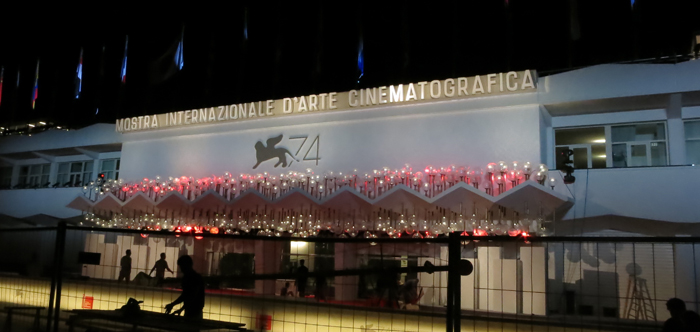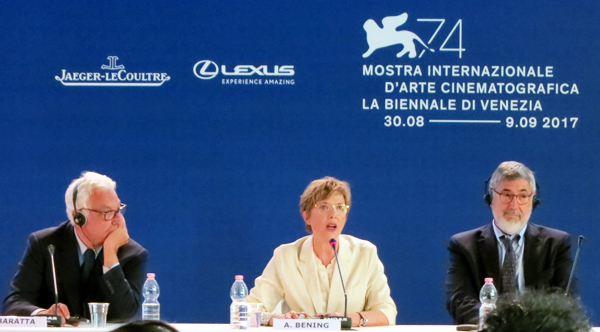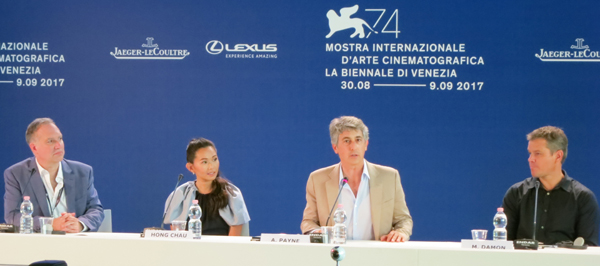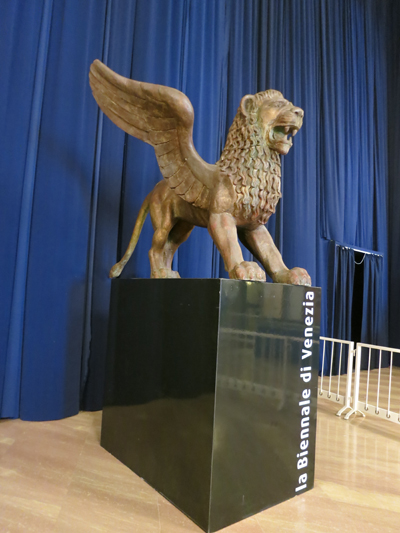Venice 2017: Early days
Thursday | August 31, 2017 open printable version
open printable version
DB here:
After the triumph of Rosita (more on that to come), the first full day of the Biennale launched with several press screenings and press conferences. The opening conference featured Festival President Paolo Baratta (below), Director Alberto Barbera, and jury heads including Annette Bening (below), Benoît Jacquot, and John Landis (below).
During that session, two subjects recurred: Netflix and Virtual Reality. Some Netflix films are playing out of competition: Our Souls at Night, with Robert Redford and Jane Fonda (who will get honorary Golden Lion awards); and Netflix’s first Italian production, Suburra. In addition, the Mostra will show all the episodes of Errol Morris’s Netflix series Wormwood. Barbera remarked that festivals must follow where auteurs lead. Now that so many filmmakers are directing telefilms and series “with the same attitude” they employ in theatrical features, festival progamming must take notice.
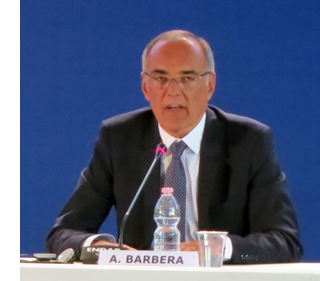 Similarly with VR. Baratta pointed out that this medium is now being used by artists, and Venice has a historical and aesthetic obligation to keep up with moving-image explorations. Barbera added that for him VR was not the future of movies; it’s a new medium that will exist alongside them. Just as film didn’t kill theatre and television didn’t kill film, VR is likely to flourish on its own. It will likely have its dedicated venues, such as MK2’s VR theatre in Paris and similar spots in Amsterdam.
Similarly with VR. Baratta pointed out that this medium is now being used by artists, and Venice has a historical and aesthetic obligation to keep up with moving-image explorations. Barbera added that for him VR was not the future of movies; it’s a new medium that will exist alongside them. Just as film didn’t kill theatre and television didn’t kill film, VR is likely to flourish on its own. It will likely have its dedicated venues, such as MK2’s VR theatre in Paris and similar spots in Amsterdam.
John Landis admitted that he was intrigued by VR and wanted to learn how to use it. Can it tell a full-length story? (Most VR pieces are short and situation-bound.) Can it focus the viewer’s attention—a key component of traditional visual narrative? Landis noticed that his experiences of VR gave the viewer great freedom of when and where to look. Could storytelling harness that freedom? It was good to see a filmmaker pondering these basic issues.
We saw the first screening of Alexander Payne’s Downsizing, a sharp and heartfelt satire on consumerism and ecology. Matt Damon and Kristen Wiig play a couple who decide to take advantage of a new technology that shrinks humans to 5-inch heights, and thus allows them to live more cheaply and reduce the strain on the planet.
The situation takes several unpredictable turns and in the face of impending disaster veers into a Capraesque optimism. Yet there’s a somberness here too, perhaps most akin to that in About Schmidt. Alexander mentioned Chekhov as an influence, and he admired the writer for realizing that emotional effects stand out against “a cold background.” The clinical scientific milieu of the downsizing operation and the arid cheerfulness of Leisureland, a sort of micro-EPCOT, provide that backdrop for the problems facing tiny Matt Damon.
In the press conference, Damon called Alexander’s direction meticulous and “sure-handed.” That shows in the film: No bouncy-camera grab-and-go, but precisely staged scenes. One sequence, that showing the medical mechanics of the downsizing process, is shot for shot as cogent and engaging a stretch of cinematic storytelling as I’ve seen in a long while. There’s also a good gag when Damon wakes up from the surgery and immediately…well, I can’t spoil it. Below, here are Jim Taylor, co-screenwriter; actor Hong Chau, who plays a Vietnames dissident; Payne; and Damon.
Our old friend Mark Johnson produced the film. It was encouraging to see the huge press turnout and the excellent reviews (Variety Hollywood Reporter, The Wrap) that Downsizing got. It goes immediately to Toronto.
Thanks to Peter Cowie, Alberto Barbera, Michela Lazzarin, and all of their colleagues for inviting and assisting us.
We have a blog entry devoted to Alexander Payne here, where he mentions his and Jim’s long-germinating plans for Downsizing. Kristin compares his work to Chekhov there too.












